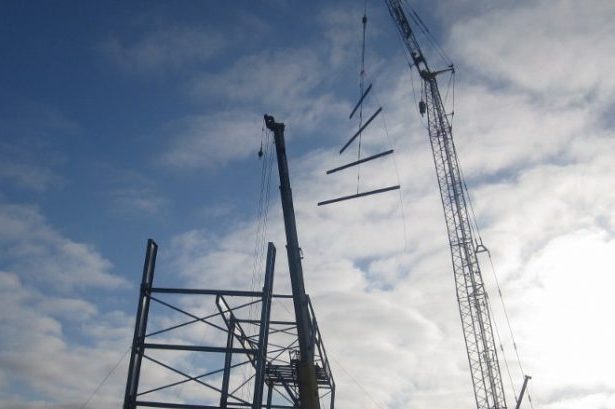The Challenges with Multi-Tiered Crane Loads

New Legislation Affects the Crane Industry
With the new laws on confined spaces taking effect, electrical safety construction regulations have also been completely reorganized. Additionally, other changes affecting the crane industry were also brought in with significantly less fanfare.
These changes relate to multi-tiered loads for cranes and to operating equipment near power lines. The new rules are more stringent than past practice and require that special procedures be developed to ensure worker’s safety. The changes came into effect in September of 2006 so everyone should be following them now. Here’s a primer on the new regulations.
Rules For Steel Erection
If you’re in the steel erection business, you probably know the term “Christmas Treeing” as related to lifting a load of beams. Basically, this is rigging up a number of structural items into a single multi-tiered load and lifting the entire group of them up to the connectors standing on the structure. The connectors then place each item in place starting with the bottom member and working up to the top. Once the hook is empty, the operator lowers it to the rigging crew on the ground to load up the next set of members while the connectors finish bolting up the steel. The process can greatly improve the speed of erection, but can also be hazardous if not carried out properly.
To address this hazard, Section 103 of the construction regulations have been greatly expanded and now give very detailed requirements. While you should check out the latest set of regulations for yourself to get the full details, here are the main highlights:
- By definition, a multi-tiered load is two or three individually rigged structural steel pieces that are vertically aligned, remain horizontal during lifting, and are all simultaneously lifted by a single crane.
- A multi-tiered load shall:
- not contain bundled together structural steel pieces
- not contain more than three structural steel pieces
- not use one structural steel piece to support another
- have each structural steel piece independently slung back to the main load hook or master link
- be lowered only by a crane using power-controlled lowering
- Before beginning a multi-tiered lifting operation, a professional engineer must develop a written procedure. Among other things, the procedure must:
- Include design drawings providing the rigging sizes and arrangement, structural steel arrangement and sizes, etc.
- Identify the crane, its capacity, maximum radius and provide any limitations of the crane
- Detail how the load weight is determined
- Identify all safety hazards like the wind, weather, other local equipment, ground conditions, etc.
- Provide a means of load control
- Specify the extent of inspection of all rigging and structural items prior to each lift
- Specify any additional inspections or other work to be carried out by a professional engineer to ensure the safety of the workers and the conditions requiring this work to be done
- The employer responsible for the multi-tiered lift must provide a written document listing (by name) each worker involved in the lift operation, their job title, and their duties
- The employer must ensure the engineered procedure is provided and reviewed with the workers and that the procedures are fully implemented. Any deviations from the engineered procedures have to be approved by the engineer in writing before proceeding with the lift.
- A copy of the engineered procedures, any deviations to the procedure, and of the document described in item 4 above has to be kept on-site while the multi-tiered operation is in progress.
- The Ministry of Labour must be informed prior to any multi-tiered hoisting operation. This is done via fax, e-mail, or telephone call.
While these changes in regulation may seem a bit onerous for an experienced steel erection company, IIA Lifting Services can help you navigate them by creating a flexible engineered procedure.
Operation of Equipment Near Power Lines
In the past, it was enough to have a signalman present to ensure the crane did not come closer than the minimum approach distance to power lines as specified in construction regulations. While that rule still exists, the updates to the electrical hazards portion of the regulations require more stringent safety measures.
The main addition is a written procedure. The constructor develops and implements a written procedure that will ensure no part of a vehicle or equipment, or its load will come closer than the minimum approach distance. The constructor then provides the written procedure to each employer on the project prior to starting work.
Make Your Work Environment Safer:
- Request written notification of electrical hazards before entering a site
- Notify the site superintendent if an unmarked electrical hazard is visible
- ALWAYS look up for electrical lines




